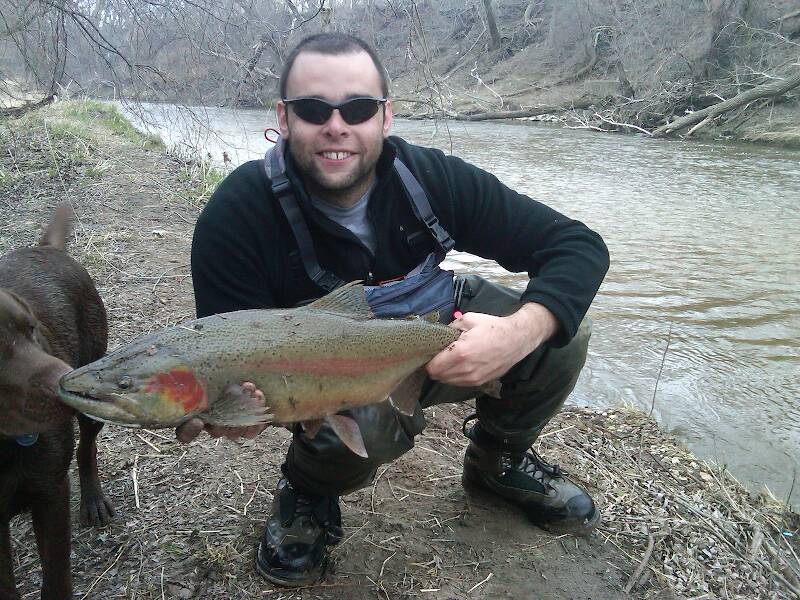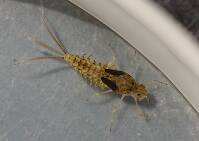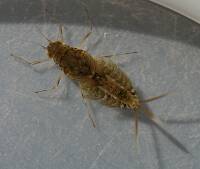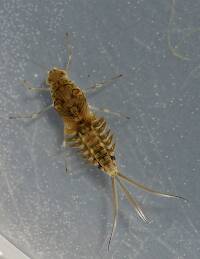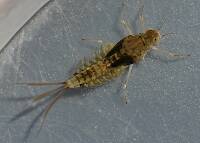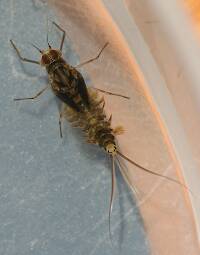
Salmonflies
Pteronarcys californica
The giant Salmonflies of the Western mountains are legendary for their proclivity to elicit consistent dry-fly action and ferocious strikes.
Featured on the forum

As far as I can tell, this species has only previously been reported from one site in Oregon along the Columbia gorge. However, the key characteristics are fairly unmistakable in all except for one minor detail:
— 4 small yellow spots on frons visible in photos
— Narrow occipital spinule row curves forward (but doesn’t quite meet on stem of ecdysial suture, as it's supposed to in this species)
— Short spinules on anterior margin of front legs
— Short rposterior row of blunt spinules on abdominal tergae, rather than elongated spinules dorsally
I caught several of these mature nymphs in the fishless, tiny headwaters of a creek high in the Wenatchee Mountains.
— 4 small yellow spots on frons visible in photos
— Narrow occipital spinule row curves forward (but doesn’t quite meet on stem of ecdysial suture, as it's supposed to in this species)
— Short spinules on anterior margin of front legs
— Short rposterior row of blunt spinules on abdominal tergae, rather than elongated spinules dorsally
I caught several of these mature nymphs in the fishless, tiny headwaters of a creek high in the Wenatchee Mountains.

Troutnut is a project started in 2003 by salmonid ecologist Jason "Troutnut" Neuswanger to help anglers and
fly tyers unabashedly embrace the entomological side of the sport. Learn more about Troutnut or
support the project for an enhanced experience here.
Wbranch on Sep 29, 2015September 29th, 2015, 5:48 am EDT
When trout are chasing minnows, or my Clouser, do they attack from the rear and swallow tail first or do they strike closer to the head and swallow head first? I've seen minnows in trouts throats usually sticking out tail first but was wondering if anyone has ever seen an authoritative paper on the subject.
Catskill fly fisher for fifty-five years.
Feathers5
Posts: 287
Posts: 287
Feathers5 on Sep 29, 2015September 29th, 2015, 6:29 am EDT
I've never seen it documented, but I've always gone with the theory that trout attack tail first and bass strike at the head and eyes. That's the reason my tying mentors gave for keeping woolly bugger tails short.
RleeP on Sep 29, 2015September 29th, 2015, 7:03 am EDT
I haven't seen any study or what I would consider authoritative documentation on this either. I'd be willing to wager though that the answer is more variable and situational than uniform. Regardless of the species of fish, the act of predation and how it actually takes place in mechanical terms (head first vs. tail first vs. whatever) is more often than not opportunistic and spur of the moment. They take what they can get in the way that works best at the time the opportunity occurs. So, no norm would be my guess.
Now, ask about fully armed crayfish and hellgrammites and the answer may change..:)
Now, ask about fully armed crayfish and hellgrammites and the answer may change..:)
Kschaefer3 on Sep 29, 2015September 29th, 2015, 7:06 am EDT
I have always heard that they strike the head first. I don't believe this is always the case, as I've seen fish short strike, but I also fish flies in the 4-6" range tied on a single shorter shanked hook and don't miss too many. I have never seen anything authoritative though.
PaulRoberts on Sep 29, 2015September 29th, 2015, 7:08 am EDT
There appears to be little on trout specifically, looking quickly. I've got a lot collected on largemouth bass, and there is a lot on some other species. Apparently, most bony fishes capture elusive prey in a similar fashion:
"Feeding by suction, accomplished by rapid expansion and contraction of the buccal and opercular cavities (together denoted as the mouth cavity), generally supported by swimming movements, is the dominant mode of prey capture in teleost fish (see Osse & Muller, 1980)"
The "swimming movements" refer to "ram feeding" open mouth and overrunning the prey. So its a combination of ram and suction, dependent on the prey type and visibility available to the fish -better visibility more ram, less visibility more suction.
Bass anyway, vary pre-capture actions depending on prey size. Large bluegills, from my own observations, are purposely attacked head first. Some research has indicated that bass aim for the center of mass on a prey fish, but these are smaller prey items. I have no good direct observations on trout attacking fishes and have read nothing that describes it. Not that it's not out there.
From my fishing, I believe that trout striking behavior is different than it is with bass. Trout appear to me to bite more than bass, although smallmouth do more biting than largemouth, apparently due to bitings effectiveness at capturing crayfish. When fishing you can feel biting as sharp and quick, compared to the largemouth's common "gallomp" (overrun/suction), or a somewhat sharp "tap" -the clamp down following suction.
So... I'm assuming trout use ram and suction -evidenced by how quickly a trout can take a lure deep- but use biting as well. Bass, largemouths in particular, are indeed specialized -taking ram and suction to the nth degree.
Now, capturing lures can be different in that lures aren't food -aren't flesh and blood- and fish may discover this at any point in the attack sequence.
Why do you ask, Matt?
"Feeding by suction, accomplished by rapid expansion and contraction of the buccal and opercular cavities (together denoted as the mouth cavity), generally supported by swimming movements, is the dominant mode of prey capture in teleost fish (see Osse & Muller, 1980)"
The "swimming movements" refer to "ram feeding" open mouth and overrunning the prey. So its a combination of ram and suction, dependent on the prey type and visibility available to the fish -better visibility more ram, less visibility more suction.
Bass anyway, vary pre-capture actions depending on prey size. Large bluegills, from my own observations, are purposely attacked head first. Some research has indicated that bass aim for the center of mass on a prey fish, but these are smaller prey items. I have no good direct observations on trout attacking fishes and have read nothing that describes it. Not that it's not out there.
From my fishing, I believe that trout striking behavior is different than it is with bass. Trout appear to me to bite more than bass, although smallmouth do more biting than largemouth, apparently due to bitings effectiveness at capturing crayfish. When fishing you can feel biting as sharp and quick, compared to the largemouth's common "gallomp" (overrun/suction), or a somewhat sharp "tap" -the clamp down following suction.
So... I'm assuming trout use ram and suction -evidenced by how quickly a trout can take a lure deep- but use biting as well. Bass, largemouths in particular, are indeed specialized -taking ram and suction to the nth degree.
Now, capturing lures can be different in that lures aren't food -aren't flesh and blood- and fish may discover this at any point in the attack sequence.
Why do you ask, Matt?
RleeP on Sep 29, 2015September 29th, 2015, 9:17 am EDT
This is very interesting stuff.
I chase smallmouth in larger creeks and smaller rivers much of the Summer. In lower flows, my favorite technique is to fish to the shaded side of the flow with good-size rabbit fur leeches by dropping them within inches of the high, step banks or along slots between cover (boulders/logs) and the bank. I keep the rod tip up to sort of suspend the fly when it lands. Probably half or more of the takes come on the drop and the rest come when after a few seconds, I raise the rod tip very, very slowly to begin to sort of "walk"/drift the fly along the bank with an assist from the current. All in all, its about 90% dead drift and 10% me actually moving the fly. I catch probably 4 times as many bass this way as I do on an actively retrieved fly.
Anyway, the leeches I fish are pretty long with the fur strip being 250% or more of hook length. I seem to miss very few fish doing it this way. Most of the takes (other than the ones that occur on the drop) feel like a light tap or "tunk" on the line rather than the sudden decisive take you get with a Clouser or Murray Marauder or any streamer, I guess. This tells me that in line with what Paul says above about largemouths, smallmouth also make extensive use of the ram and suction method, especially when attacking a very slow moving prey like my leeches.
Fascinating stuff...
I chase smallmouth in larger creeks and smaller rivers much of the Summer. In lower flows, my favorite technique is to fish to the shaded side of the flow with good-size rabbit fur leeches by dropping them within inches of the high, step banks or along slots between cover (boulders/logs) and the bank. I keep the rod tip up to sort of suspend the fly when it lands. Probably half or more of the takes come on the drop and the rest come when after a few seconds, I raise the rod tip very, very slowly to begin to sort of "walk"/drift the fly along the bank with an assist from the current. All in all, its about 90% dead drift and 10% me actually moving the fly. I catch probably 4 times as many bass this way as I do on an actively retrieved fly.
Anyway, the leeches I fish are pretty long with the fur strip being 250% or more of hook length. I seem to miss very few fish doing it this way. Most of the takes (other than the ones that occur on the drop) feel like a light tap or "tunk" on the line rather than the sudden decisive take you get with a Clouser or Murray Marauder or any streamer, I guess. This tells me that in line with what Paul says above about largemouths, smallmouth also make extensive use of the ram and suction method, especially when attacking a very slow moving prey like my leeches.
Fascinating stuff...
PaulRoberts on Sep 29, 2015September 29th, 2015, 10:24 am EDT
Yes, LM and SM are very similar in strike behavior, just that SM are more apt to bite. In my post above I sort of jumped around a bit. One researcher -who looked closer than most- (at bass) identified three jaw actions: bite, engulf (ram), suction. These can be combined along a sliding scale depending on what's needed.
I'm making a semi-educated guess that trout employ biting too, based on what I feel telegraphed through graphite.
A dropping bait is a very real attractor/trigger. That motion just happens to be one of the "neural pre-programs" that some fish carry in their brain's visual processing center. It's wired to recognize that dropping motion -apparently something that indicates vulnerability. Both LM and SM respond strongly to this and I use it a lot.
I just happen to be writing about this very thing -feeding behavior and jaw mechanics- in my bass writing.
I'm making a semi-educated guess that trout employ biting too, based on what I feel telegraphed through graphite.
A dropping bait is a very real attractor/trigger. That motion just happens to be one of the "neural pre-programs" that some fish carry in their brain's visual processing center. It's wired to recognize that dropping motion -apparently something that indicates vulnerability. Both LM and SM respond strongly to this and I use it a lot.
I just happen to be writing about this very thing -feeding behavior and jaw mechanics- in my bass writing.
Wiflyfisher on Sep 29, 2015September 29th, 2015, 12:19 pm EDT
I too think it depends on the type of prey.
A bluegill has stiff, sharp spines that they can protrude upwards in their dorsal fin. A predator fish trying to swallow a bluegill from behind may have it lodged in it's throat. Probably the same thing with a bullhead.
I have also caught Smallies that were stuffed with baby perch fry and those seem to be in every direction in the fish.
Common minnows don't have stiff, sharp spines in their dorsal fins, so I believe they can be sucked in from either direction if the predator is fast enough. I have had chubs take my fly and I have watched big browns come up from behind and take my chub, hook, leader and all. I have also caught big browns a few times of the years with chub and/or minnow still in their mouth and some are head first and some have been tail first in the fish's mouth.
Recently out West in the slower weedy sections of the big rivers I saw big trout swirling across the top of the weeds. My guess was they were zeroing in on unsuspecting minnows that lurk behind the clumps of weeds under the water. I gotta believe they suck those minnows in from behind, no time to waste or the minnows will dart into the heavy weeds. (In some other cases I think they were chasing other trout out of their feeding territory.)
My unscientific $0.02. :-)
A bluegill has stiff, sharp spines that they can protrude upwards in their dorsal fin. A predator fish trying to swallow a bluegill from behind may have it lodged in it's throat. Probably the same thing with a bullhead.
I have also caught Smallies that were stuffed with baby perch fry and those seem to be in every direction in the fish.
Common minnows don't have stiff, sharp spines in their dorsal fins, so I believe they can be sucked in from either direction if the predator is fast enough. I have had chubs take my fly and I have watched big browns come up from behind and take my chub, hook, leader and all. I have also caught big browns a few times of the years with chub and/or minnow still in their mouth and some are head first and some have been tail first in the fish's mouth.
Recently out West in the slower weedy sections of the big rivers I saw big trout swirling across the top of the weeds. My guess was they were zeroing in on unsuspecting minnows that lurk behind the clumps of weeds under the water. I gotta believe they suck those minnows in from behind, no time to waste or the minnows will dart into the heavy weeds. (In some other cases I think they were chasing other trout out of their feeding territory.)
My unscientific $0.02. :-)
John S.
https://WiFlyFisher.com
https://WiFlyFisher.com
Wbranch on Sep 29, 2015September 29th, 2015, 5:06 pm EDT
Paul,
For two reasons; when I throw Clousers (many are tied in circle hooks) I get many boils behind the fly with no resultant take. I also get many, many, short strikes where there is often a boil, but not always, followed by a aggressive strike but no hookup. A note about the circle hooks - When I do hook up most of the hooks are in the corner of the mouth as many articles have mentioned but due to the point really being somewhat hidden I totally miss far more fish on the circle hook than a conventional hook. I imagine the geometry of the circle hook does not lend itself very well to hookups in the bottom or top fleshy parts of the mouth but when the fish turns the hook does get caught in the corner of the mouth.
I wonder if when I do get a solid hook up is it because the trout captured the prey (fly) near the head or mid point rather than coming up from behind and trying to inhale the fly. Just writing this makes me wonder if the
"boil" behind the fly is caused by the sucking motion of the trout as it goes in to capture the fly? If it was a real minnow trying to escape a pursuing trout would the boil be strong enough to suck the prey into the trout's mouth? Since I'm stripping the fly pretty aggressively the sucking motion does not work and the prey escapes. Maybe if I stripped slower the boil would translate into a hooked trout as the predator would overtake the prey and get hooked.
When I spin fish for smallmouth I often use soft baits and when the fish doesn't overtake the bait and get hooked I often feel a biting type of take, like a tap, tap, tap before I set the hook.
Why do you ask, Matt?
For two reasons; when I throw Clousers (many are tied in circle hooks) I get many boils behind the fly with no resultant take. I also get many, many, short strikes where there is often a boil, but not always, followed by a aggressive strike but no hookup. A note about the circle hooks - When I do hook up most of the hooks are in the corner of the mouth as many articles have mentioned but due to the point really being somewhat hidden I totally miss far more fish on the circle hook than a conventional hook. I imagine the geometry of the circle hook does not lend itself very well to hookups in the bottom or top fleshy parts of the mouth but when the fish turns the hook does get caught in the corner of the mouth.
I wonder if when I do get a solid hook up is it because the trout captured the prey (fly) near the head or mid point rather than coming up from behind and trying to inhale the fly. Just writing this makes me wonder if the
"boil" behind the fly is caused by the sucking motion of the trout as it goes in to capture the fly? If it was a real minnow trying to escape a pursuing trout would the boil be strong enough to suck the prey into the trout's mouth? Since I'm stripping the fly pretty aggressively the sucking motion does not work and the prey escapes. Maybe if I stripped slower the boil would translate into a hooked trout as the predator would overtake the prey and get hooked.
When I spin fish for smallmouth I often use soft baits and when the fish doesn't overtake the bait and get hooked I often feel a biting type of take, like a tap, tap, tap before I set the hook.
Catskill fly fisher for fifty-five years.
PaulRoberts on Sep 30, 2015September 30th, 2015, 6:59 am EDT
First, I have not used circle hooks but always assumed they were best for live bait, or baits that would assuredly be taken fully inside the mouth. I know there was talk of them for FF some while back. I would suspect trout and streamers would be a worst case scenario for them. But that's guesswork as I've never tried them.
The short strikes and boils you are seeing are most likely aborted strikes. Lures can be great attractors but fail at point blank range -where all fishes have the most visual acuity. Add to this the likely fact that trout use biting as a component of their strikes, and the use of circle hooks, probably explains all those misses. The ones that got pinned probably were able to engulf the fly, the fish being committed enough, big enough, and following through with an overrun (ram/engulf) strike. That's asking a lot of the fish, and the tackle, right there.
That's my best guess as to what you're seeing.
The taps you are feeling with bass are almost assuredly the bass having already taken the bait in and now biting down on it with its pharyngeal teeth pads. That's where the taste buds are too. By the time you are feeling that, they are either about to ingest or spit -time to set the hook. I've gone barbless with soft plastics for some time now bc of the ingestion issue. The esophagus is a bad, infection prone, place to stick a hook. Barbless makes release of deep hooked fish much less traumatic.
The biting that bass use tends to be more like the use of pliers, and is used by smallmouth to seize crayfish and wrest them from the substrate. Smallies will literally use their beaks like pliers, root right in and pinch down (bite). It's all in the lips (premaxillaries) at this point. After this they reposition the cray and swallow tail first. If the pincers are big and active the bass may spit and re-ingest. It's possible you are feeling this at times, but often such activity is felt as a missed strike. It's so easy to yank a bait from a bass' mouth when its not clamped down on (like back in the pharyngeal pads). The bite scenario is not as common with artificial lures anyway, since most anglers fish lures off bottom, where bass commonly use ram/suction.
LM's are not the biters that SM are and the only time I've seen it is when they are tentative, producing more of a nip than a strong bite like SMs use. SMs have very strong jaw pressure, whereas LMs not so much. Different animals in this respect.
John, those are interesting observations on trout takes, which adds to the discussion above: Unlike bass, trout have sharp teeth that would aid in biting type strikes. Biting initially secures the prey, which can then be repositioned if needed (esp important with larger prey) or just sucked in to the pharyngeal area. In trout, there are teeth there too and for them it's more shredding and macerating than crushing as in bass. And... yeah, spines figure in big with bass; evidence for the arms race that goes on between predator and prey.
The short strikes and boils you are seeing are most likely aborted strikes. Lures can be great attractors but fail at point blank range -where all fishes have the most visual acuity. Add to this the likely fact that trout use biting as a component of their strikes, and the use of circle hooks, probably explains all those misses. The ones that got pinned probably were able to engulf the fly, the fish being committed enough, big enough, and following through with an overrun (ram/engulf) strike. That's asking a lot of the fish, and the tackle, right there.
That's my best guess as to what you're seeing.
The taps you are feeling with bass are almost assuredly the bass having already taken the bait in and now biting down on it with its pharyngeal teeth pads. That's where the taste buds are too. By the time you are feeling that, they are either about to ingest or spit -time to set the hook. I've gone barbless with soft plastics for some time now bc of the ingestion issue. The esophagus is a bad, infection prone, place to stick a hook. Barbless makes release of deep hooked fish much less traumatic.
The biting that bass use tends to be more like the use of pliers, and is used by smallmouth to seize crayfish and wrest them from the substrate. Smallies will literally use their beaks like pliers, root right in and pinch down (bite). It's all in the lips (premaxillaries) at this point. After this they reposition the cray and swallow tail first. If the pincers are big and active the bass may spit and re-ingest. It's possible you are feeling this at times, but often such activity is felt as a missed strike. It's so easy to yank a bait from a bass' mouth when its not clamped down on (like back in the pharyngeal pads). The bite scenario is not as common with artificial lures anyway, since most anglers fish lures off bottom, where bass commonly use ram/suction.
LM's are not the biters that SM are and the only time I've seen it is when they are tentative, producing more of a nip than a strong bite like SMs use. SMs have very strong jaw pressure, whereas LMs not so much. Different animals in this respect.
John, those are interesting observations on trout takes, which adds to the discussion above: Unlike bass, trout have sharp teeth that would aid in biting type strikes. Biting initially secures the prey, which can then be repositioned if needed (esp important with larger prey) or just sucked in to the pharyngeal area. In trout, there are teeth there too and for them it's more shredding and macerating than crushing as in bass. And... yeah, spines figure in big with bass; evidence for the arms race that goes on between predator and prey.
Quick Reply
Related Discussions
Topic
Replies
Last Reply
0
Jan 27, 2017
by Mcflyangler
by Mcflyangler



